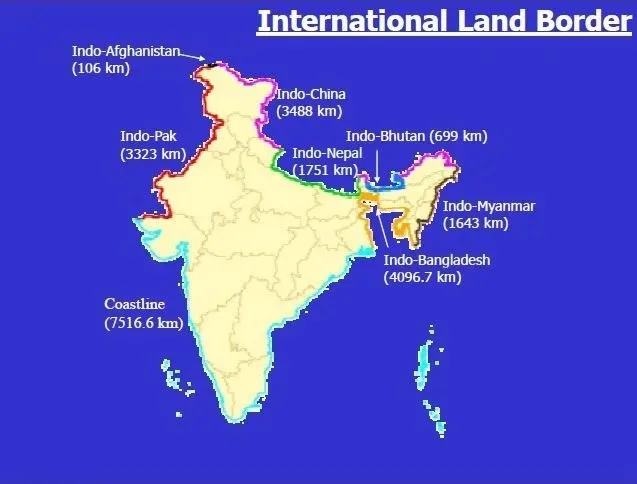Syllabus: GS3/ Internal Security
Context
- The Union government has approved the construction of border fencing and roads along the border between India and Myanmar at an approximate cost of ₹31,000 crore.
International Border of India
- India currently has more than 15000 km of land borders and more than 7500 km of maritime borders.

- It shares land borders with seven countries including Afghanistan, Pakistan, China, Nepal, Bhutan, Bangladesh and Myanmar. The borders with the countries are as;
- Bangladesh: 4096.70 kms running along West Bengal, Assam, Meghalaya, Tripura and Mizoram.
- Pakistan: 3323 kms running along Gujarat, Rajasthan, Punjab, Union Territory of Jammu & Kashmir and Union Territory of Ladakh.
- China: 3488 kms running along Arunachal Pradesh, Sikkim, Uttarakhand, Himachal Pradesh and the Union Territory of Ladakh.
- Nepal: 1751 kms running along Uttarakhand, Uttar Pradesh, Bihar, West Bengal and Sikkim.
- Bhutan: 699 kms running along Sikkim, West Bengal, Assam and Arunachal Pradesh.
- Myanmar: 1643 kms running along Arunachal Pradesh, Nagaland, Manipur and Mizoram.
- Afghanistan: 106 kms running along the Union Territory of Ladakh.
Need for Managing the Borders
- Porosity of Borders: Many parts of India’s borders are porous, allowing illegal crossings of people, goods, and contraband such as drugs and weapons.
- Cross-Border Terrorism: India faces threats of cross-border terrorism, particularly from Pakistan-based militant groups operating in Jammu and Kashmir.
- Ethnic and Tribal Dynamics: India’s border regions are inhabited by diverse ethnic and tribal communities with historical, cultural, and social ties across borders.
- Managing these communities’ aspirations, addressing their grievances, and preventing their exploitation by external forces require nuanced approaches to border management.
- Dispute over Borders: India has unresolved border disputes with neighboring countries, most notably with China and Pakistan.
- These disputes lead to occasional tensions and confrontations, necessitating constant vigilance and diplomatic efforts to maintain peace and stability along the borders.
- Infrastructure Development: Many border areas in India lack basic infrastructure such as roads, communication networks, and border outposts, hampering the effectiveness of border management efforts.
- Humanitarian Concerns: India shares borders with countries experiencing political instability, humanitarian crises, and refugee influxes.
India’s border management
- Border Infrastructure Development: The Border Roads Organisation (BRO) has constructed over 8,500 kms of roads and more than 400 permanent bridges.
- Atal Tunnel, Sela Tunnel and Shikun-La Tunnel, which is going to be the world’s highest tunnel, will prove to be milestones in border area development.
- Trans-Arunachal Highway is a strategic project to enable quick and effective response against potential aggression by China.
- Border Monitoring: Construction of fences, floodlights, roads, Border Out Posts (BOPs), and Company Operating Bases (COBs) for constant surveillance and rapid response to threats.
- Security Measures: Central Armed Police Forces (CAPFs), under the Ministry of Home Affairs (MHA), guard borders in peacetime.
- The Indian Army takes charge of border security during active hostilities to defend against external aggression.

- Border Area Development Programme (BADP): Launched in 1986-87 for the balanced development of border areas in states bordering Pakistan—Jammu & Kashmir, Punjab, Gujarat, and Rajasthan—later extended to all land borders.
- Vibrant Villages Programme (VVP): Approved in 2023 for the comprehensive development of selected border villages in Arunachal Pradesh, Himachal Pradesh, Sikkim, Uttarakhand, and Ladakh.
- Cross-Border Trade: Construction of integrated checkposts and trade facilitation centers has streamlined customs clearance and reduced trade barriers.
- However the Union Home Ministry recently scrapped the Free Movement Regime (FMR) along the Myanmar border, which allowed local residents to travel 16 km into each other’s territory without documents.
Way Ahead
- India’s evolving approach to border management is a mix of security measures, infrastructure development, and strategic cooperation with its neighbors.
- The continuous development of border regions, enhanced surveillance, and improved trade facilities reflect the country’s commitment to ensuring national security while fostering regional prosperity.
Source: TH
Previous article
Bio-RIDE Scheme to Support R&D in Biotechnology
Next article
Developments in Spintronics